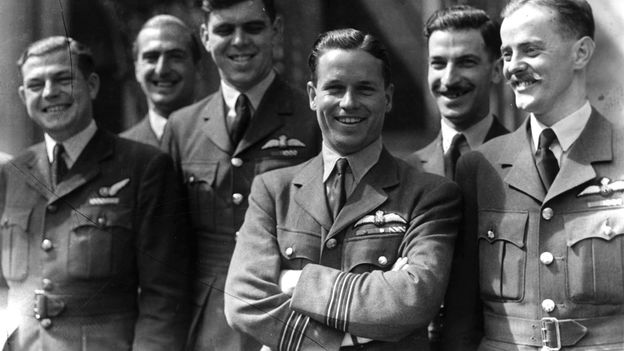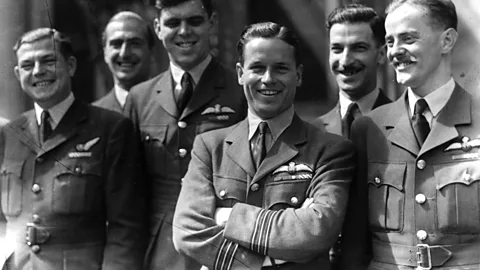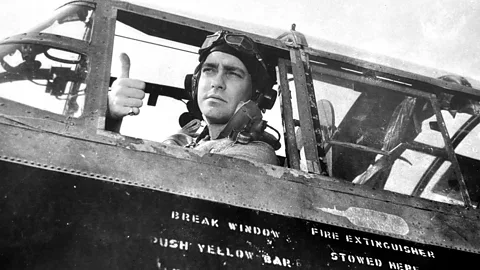
The true story of World War Two’s Dambusters raid
- Culture
- May 12, 2025
 Getty images
Getty imagesIn May 1943, a RAF squad formed by specials embarked on a daring mission illuminated by the moon, but its success had a great cost. In 1976, the BBC spoke with one of the aviators who did home alive.
However, through the months of April 1943, Jack Buckley practiced low -level flight and navigation night for a high secret mission as part of the Royal Air Force 617 squad. The security of operation Chastise was so tight that no one in the squad formed hurriedly, composed of 133 aviators of the United Kingdom, USA I really knew what they were training for.
There were many speculations, “but nobody was close to the truth,” Buckley recalled BBC when he was interviewed in 1976 at RAF Scampton in Lincolnshire. “Someone had the brilliant idea that we could be dropping tanks in the desert, and there were other remote ideas [such as] Going against the Tirpitz [German battleship]. “Ultimately, Squadron 617 would be known as the bold and dangerous mission in which they were about to embark: the Dambusters.
At 21:28 of May 16, 1943, 82 years ago this week, the first of the 19 Special Modified Lancaster bombers retired for a precision raid that aimed to paralyze the third Reich war machine. Its objective was three great dams in Möhne, Eder and Sorpe in the Ruhr region, the military-industrial heart of Germany.
The dams supplied water and hydroelectric energy to the surrounding German factories that were manufacturing armaments. However, it was that if the dams could be destroyed, the resulting floods would cause catastrophic damage to the production and moral of the Nazis war. A plan to attack the dams had previously been raised in the war, but since the flight route was heavy, and no plane at that time could transport a pump large enough to destroy them, the task was impossible impossible. But the plane that is removed in May 1943 carried a new powerful weapon: the rebound bomb.
Code name support, the specially built explosives had been invented by the aircraft engineer, Dr. Barnes Wallis. Wallis had realized that narrower bombs could have the required effect if they were detonated in the right place, underwater near the base of the dam. He designed a canyon -shaped pump that could jump through the surface of the water in the same way that a stone does when it is slippery. This allowed explosives to avoid underwater protective networks that were placed around the dams to avoid torpedoes.
But for the pumps to work, they had to be removed from the exact altitude and the correct speed. A plane would need to fly through water at a height of only 60 feet (18 m) and a speed of 232 mph (373 kmh). This would allow the pump to bounce the dam, where its back will run down the side of the dam until it reduced a depth of 30 feet (9 m) and explode. Wallis had modeled this trajectory by sneaking the marbles through a bathtub full of water in its rear garden.
The weapons were still too large to fit into the Lancaster bomb bay, so the airplanes were modified so that the pumps could be transported below, and much of the aircraft armor had to remove it so that they were light enough to fly.
High voltage anti -aircraft guns and electric lines
The 617 squad bombers departed in three waves, each aimed at a different dam. Buckley was in the first wave of nine planes led by the 24 -year -old commander of the Guy Gibson squad. As the rear gunner in a bomber piloted by Dave Shannon, Buckley told the BBC that he remembered feeling “Slipper that we were on the way” while the plane left the track. “We set up for the enemy coast. It was a full moon, it was almost like daylight,” he said.
The dangerous mission required exceptional flight skills and precision navigation. To avoid radar, the lancasters needed to fly at low altitudes on flight routes that entered and left positions where there were known anti -aircraft weapons. At least three planes were shot down when they deviated from their routes, while two others crashed because they flew low enough to hit the high voltage electric lines.
Buckley Lancaster was one of those who arrived at the appointment with the Möhne dam 2,000 feet long (650 m). Gibson decided to take the bombing, while the Esters surrounded, waiting for their chance. Möhne’s approach was especially dangerous. Surrounded by tree -covered hills, the crew was exposed to Flak of the gunners in the towers while falling under the surface of the water. When it comes to Buckley’s bomber turn, four other lancasters had already dropped their bombs, and an plane had crashed after being hit by the enemy fire and the explosion of the rebound bomb itself. But Möhne’s dam was still standing.
Because the lancaster altimeter was not precise enough, the spotlights had installed at each end of the aircraft to tell the aviators when they were at the right height. “Cirlamos, we had to have 60 feet exactly, we had a focus on the aircraft nose and a focus on the tail and converged exactly 60 feet,” Buckley said. “Number five was [pilot David] Maltby, well, dropped his successful weapon. We were in the race and Gibson called us: the dam was gone. “
When the dam exploded, a wave of flood water of 30 feet (10 m) emerged through the bedroom, sweeping everything to its path. But Buckley did not have much time to enjoy his feeling of relief, since Gibson “ordered Ourelves, [and planes piloted by] Henry Maudslay and Les Knight will go to the Eder dam. ”
The Eder dam was not defended by anti -aircraft weapons, but its short approach, starting with a steep immersion, made it an even more challenging goal. “Well, we had to lower a very steep hill, level, put the spotlights, get the exact height and then put a complete impulse so that the other side leaves the valley. Very diffusion,” Buckley said. “We had five races possible before attacking and making a successful blow in the dam is me, which caused a violation.”
Knight’s plane followed Buckley’s. Another bomb that bounced hit Eder, causing collapse to, sending a million tons of water that pours in the Western Valley of Ruhr. Only two Lancasters managed to reach the third objective in Sorpe. And because the dam was built of concrete covered by thousands of tons of land, it was able to withstand the pumps fell on it, suffering only partial damage.
The human cost of the raid
The damage caused by the raid was extended, with the 330 million tons of flood water by raped dams that extended for about 50 miles (80 km). Twelve war production factories and two power plants were destroyed, and the most were damaged scores. The mines were flooded, and each 30 mile bridge (48 km) under the rapid Mohne dam was swept. Thousands of cultivation land acres were flooded, with cattle drowned in the waters.
But the human cost was also extensive. The estimates vary, but bets 1,200 and 1,600 people were killed, most of which were civilians. The victims included 749 prisoners of war, many of whom were workers adorned from Poland, Russia and Ukraine. They were based on a camp just below Eder’s dam and drowned in the floods. Of the 19 Lancaster bombers that left that day, eight were damaged or knocked down. From the 133 Aircrew, 53 were killed. Three others were captured and became prisoners of war.
 Alamia
AlamiaGeorge ‘Johnny’ Johnson, who was part of the formation that attacked the Sorpe dam, told Hardtalk of BBC in 2018 that he remembered the inventor of the devastated bomb when he learned the number of deaths of the air creates. “Barnes Wallis exploded in tears and said:” I have killed all those young people. I will never do something like that again. “
Johnson told the history of the witnesses of the BBC in the same year: “I still felt that what we did, we had to do our best, but made me realize the amount of other effects that the war has on non -combatants, civilians, the number of expelled people.”
The long -term strategic impact of the Dambusters raid is still very discussed. Following the attack, Hitler sent an army of forced labor to repair the damage, and the production of war in the Ruhr valley resumed again in a matter of months. The dams were rebuilt in just five months, using enslaved workers who work all day and all night. Hitler’s youth, the German troops and Wer’s prisoners were gathered to repair bridges and factories. Only the loss of electrical energy in the region hard only two weeks. But the raid meant that Hitler was forced to commit large amounts of labor and money to the reconstruction effort, diverting the resources that Kuld has gone to his troops fighting in the east or underpinning the Nazi coastal defenses against the defenses.
The surviving aviators of Squadron 617 were praised as heroes upon their return and the raid made first -flat news. Later he would immortalize in the 1955 film The Dam Busters, starring Richard Todd and Michael Redgrave, who, along with his moving melody, helped consolidate the attack in the national folklore of the United Kingdom.
Gibson received the Cross Victoria and 33 from the aviators involved received honors for their roles in the raid, and both Johnson and Buckley received the distinguished flying cross. Gibson would do it a year later when his plane crashed on his way from a mission in Germany. Only 48 men of the 133 who tangled in the raid would live to see the end of the war.
“After informing, we got used to disaster and had some food and then we started a wonderful party,” Buckley played the BBC in 1976. It was a slippery celebration that lasted two days. Despite the sudden loss of so many of his comrades, there was no time to cry properly before the survivors fly again. “Well, we used to through war, so we could. We drank their health and that was all.”
To get more stories and radio scripts never before published in your entry tray, register in the In the Bulletin of HistoryWhile The essential list It offers a selected selection of characteristics and ideas twice a week.


